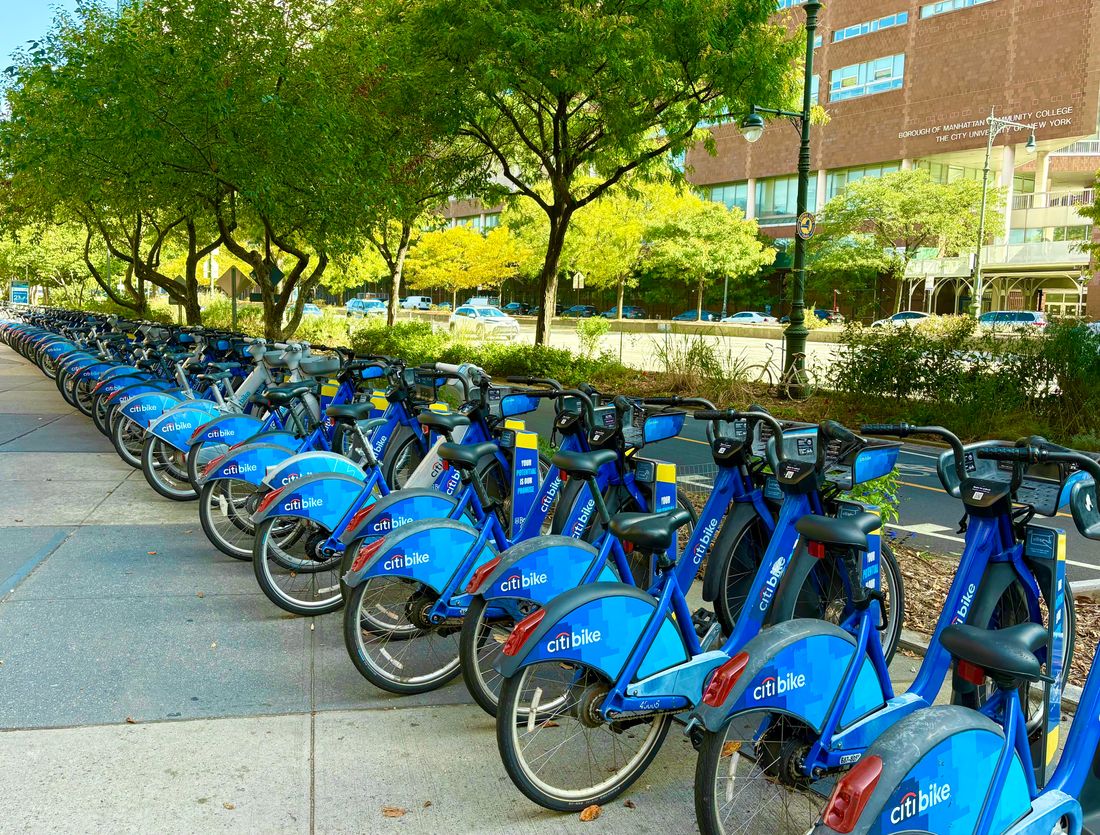Citibiking to a Better NYC
The Citi Bike system is a perfect example of how thoughtful infrastructure can have a positive impact on city dwellers—New York should create more initiatives like it.
Reading Time: 4 minutes
Citi Bikes have transformed the landscape of New York’s infrastructure since being introduced to the city in 2013. Today, NYC has over 1,500 miles of bike lanes and 35,000 Citi Bikes across boroughs. Since 2009, biking in the city has increased by 121%—and for good reason. Biking is relaxing and scenic, avoids subway delays, and is often the quickest way to get from one place to another, especially as the network of bike stations expands. The popularity of biking is rising, making Citibiking New York’s fastest growing network of transportation.
Citibiking has emerged as one of NYC’s most successful infrastructure projects, defying the typical pitfalls for shared infrastructure. There’s a lot New York can learn from Citi Bikes to help design more public infrastructure in the city that can be treated well and enjoyed by many. High quality, well-thought-out shared infrastructure can help foster stronger communities, as well as a better quality of life for individuals.
Any massive, new public project like Citibiking is susceptible to a myriad of problems. Traditionally, shared infrastructure has been neglected and run down, a dilemma known as the Tragedy of the Commons. This term was coined by Garett Hardin in 1968, and suggests that if a resource doesn’t have individual ownership, it’s often treated poorly since nobody feels responsible for its maintenance. Hardin used an example of open pasture where all livestock can graze: Villagers seeking to reduce wear on their own private property and maximize profits add more of their livestock to the open pasture, and it doesn’t take long before the field is overgrazed and can no longer support all the animals that feed off it. So how does the shared infrastructure of citibiking defy the Tragedy of the Commons? Research suggests that there are three key elements in the Citi Bike system that convince people to take responsibility for public bikes: smart design, consistent maintenance, and effective deterrents against misuse.
Citi Bikes were created with city life in mind, and carefully designed to be robust and stable. That is partly why they are so heavy; they are meant to be able to withstand accidents that are bound to happen in busy urban areas. The bikes might be clunky, but they are sturdy, well-built machines. The e-bikes are especially durable, and their powerful batteries and motors make them incredibly fit for city transportation. Since the quality of Citi Bikes themselves is high, they’re able to last through the demands of moving around NYC.
Citi Bikes are also well-maintained to ensure that they do not fall into disrepair. Workers move bikes to empty stations, swap out depleted e-bike batteries, and fix broken gears, handles and wheels. This August, technicians made over 4,500 station visits to address problems, and made almost 24,000 bicycle repairs. Citi Bike’s app allows people to report theft, misuse, and damage very easily: users can press a button on the station once the bike is docked that takes them to a page to disclose any issues. Once a broken bike has been recorded through this system, it emits a red light so that others know not to use it.
Upholding the shared infrastructure of Citi Bikes wouldn’t be possible without the disincentive to displace or steal bikes: a $1,200 fine. This seems to counter most possible crimes very well—there were 10 reported vandalism cases in August, and 13 in July; considering that around five million average users ride per month, these numbers are very low.
Even with these factors, people sometimes complain about the poor conditions they find their bikes in—maybe the gears are stuck or simply don’t go high enough, or using the brake takes some effort. Many New Yorkers scorn Citi Bikes as unreliable or impractical, while others simply wonder if Lyft, Citi Bike’s parent company, can keep up with the increasing demand throughout the city. But despite how contested Citi Bikes have become, they are still one of the most successful public infrastructure programs in the entire world.
While many have concerns about the impracticalities of building new public infrastructure for a variety of valid reasons such as cost and vandalism, Citi Bikes in NYC prove that there are ways to create and support public projects that are beneficial to all and can serve as a blueprint for new shared projects. After the success of the Citi Bike program, New York may find that electric scooters could be an easy and fun transportation alternative. Another possibility could include expanding ping-pong tables and other stationary sports equipment in parks and common spaces across the city, something which would also build community. New York could also try to implement more incentives and programs for public bathrooms, pools, park grills, and even housing based on the efficiency and success of the Citi Bike measures. The Citi Bike system is a prime example of the good outcomes when New Yorkers are given purposeful and meticulous programs to properly build and maintain infrastructure, and the city should create similar initiatives to further improve the standard of living in New York.
